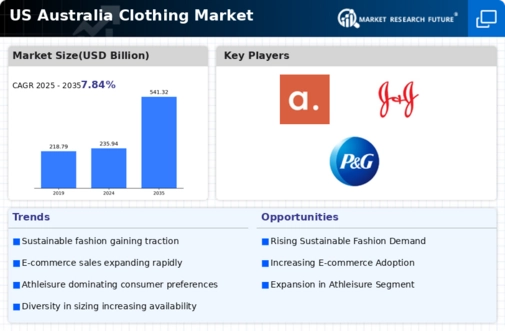Changing Consumer Preferences
Consumer preferences in The Australia Clothing Market are evolving rapidly, influenced by factors such as lifestyle changes and cultural shifts. There is a noticeable trend towards casual and comfortable clothing, driven by the increasing popularity of remote work and leisure activities. This shift is reflected in the sales data, which indicates that athleisure wear has seen a growth of approximately 15% in recent years. Additionally, consumers are becoming more conscious of their purchasing decisions, favoring brands that align with their values. This change in consumer behavior is prompting retailers in the australia clothing market to adapt their offerings, focusing on comfort, versatility, and ethical production practices.
Demographic Shifts and Urbanization
Demographic changes and urbanization are significant drivers of The Australia Clothing Market. As urban populations grow, there is an increasing demand for diverse clothing options that cater to various lifestyles and cultural backgrounds. The rise of millennials and Gen Z as key consumer segments is particularly noteworthy, as these groups prioritize sustainability and inclusivity in their fashion choices. This demographic shift is expected to influence market dynamics, with an estimated 30% of consumers in these age groups willing to pay a premium for sustainable products. Consequently, the australia clothing market must adapt to these evolving demographics to remain competitive and relevant.
Technological Advancements in Retail
The integration of advanced technologies in the retail sector is reshaping The Australia Clothing Market. Innovations such as augmented reality (AR) and virtual fitting rooms enhance the shopping experience, allowing consumers to visualize clothing on themselves without physical trials. This technological shift is likely to attract a tech-savvy demographic, potentially increasing sales by up to 20% in the next few years. Furthermore, the use of artificial intelligence (AI) in inventory management and customer service is streamlining operations, reducing costs, and improving customer satisfaction. As retailers adopt these technologies, the australia clothing market may witness a significant transformation, catering to the evolving preferences of consumers.
Economic Factors and Consumer Spending
Economic conditions significantly influence The Australia Clothing Market, as consumer spending patterns fluctuate with changes in the economy. Factors such as employment rates, disposable income, and inflation directly impact purchasing behavior. In recent years, a steady increase in disposable income has led to a rise in consumer spending on clothing, with an estimated growth of 5% in the sector. However, economic uncertainties can lead to cautious spending, prompting consumers to prioritize essential purchases over discretionary items. Retailers in the australia clothing market must remain vigilant and adaptable to these economic shifts to optimize their strategies and maintain profitability.
Influence of Social Media and Influencers
The impact of social media and influencers on The Australia Clothing Market cannot be overstated. Platforms like Instagram and TikTok have become vital marketing channels, where fashion trends can go viral overnight. Influencers play a crucial role in shaping consumer perceptions and driving purchasing decisions, particularly among younger demographics. Brands that effectively leverage social media marketing strategies may experience a substantial increase in brand awareness and sales. Recent studies suggest that approximately 70% of consumers are influenced by social media when making clothing purchases. Thus, the australia clothing market must harness the power of digital platforms to engage with consumers and promote their products.














Leave a Comment